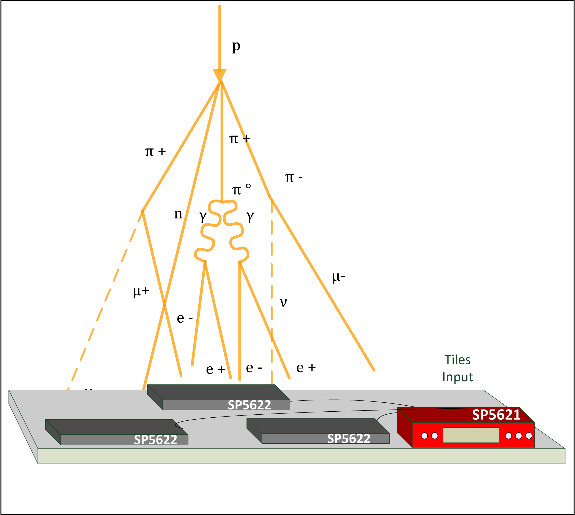| Difficult | Execution Time | Data Analysis | Radioactive Sources |
|---|---|---|---|
| Yes | No |
Hardware setup
This experiment guide is referred to the SP5620CH educational kit.
Equipment: SP5620CH – Cosmic Hunter
| Model | SP5621 | SP5622 (x2) |
|---|---|---|
| Description | Coincidence Module | Detection System |
Purpose of the experiment
Detection of the cosmic showers by using the coincidence of three scintillating tiles located adjacent to one another on a flat surface.
Fundamentals
Cosmic ray showers are cascades generated by cosmic rays interacting with the atmosphere. They were originally discovered by chance during the application of coincidence counters for the study of the cosmic rays. In some of these experiments coincident events were detected when the detectors were not assembled in telescopic structure, but rather were organized near one another on a flat surface.
The intuition of this new physical phenomenon was formulated by Bruno Rossi in 1934 and is considered to be the first evidence of the existence of extended atmospheric showers. The Italian physicist was the first to deduce that the multiplicative processes made by the cosmic rays produced in the atmosphere are identical to those observed in dense materials such as lead. Several groups of scientists studied this phenomenon. In particular, Auger and Maze undertook a campaign of systematic studies of these showers and even managed to measure coincident events between detectors as far apart as 300 meters! Auger and collaborators discovered the Extensive Atmospheric Showers [EAS] of very high energy, i.e. the energy of the primary particles at the origin of these events is around 1016 eV.
Carrying out the experiment

Experimental setup block diagram
Connect the cable connectors of the three SP5622 to the tile inputs located on the rear panel of the SP5621 module. Arrange the tiles on a flat surface some distance apart from one another. Power on the SP5621 module and start the acquisition via the front panel START button. When a charged particle crosses the black tile it’s energy is converted into scintillation light. The photons which are produced are detected by the photosensor and converted into an electrical signal. The number of counts for each scintillator may be viewed via the SP5621 display. Select triple scintillator coincidence mode via the related button on the front panel, then select the integration time of the measurement. Because event acquisition will only take place only in the presence of the coincidence, all those events coming from a cosmic particle that crosses only one scintillating tile will be automatically discarded.
An extended geometry can be realized simply by using additional Cosmic Hunter. Additionally, it could be interesting to observe Air Showers as a function of the altitude.
Results
Observation of the cosmic shower phenomenon.

Scheme of an air shower detected by several detectors and its vertical profile [RD6] (Ref. Frank G. Schröder, Radio detection of cosmic-ray air showers and high energy neutrinos, 2017, https://doi.org/10.1016/j.ppnp.2016.12.002).


